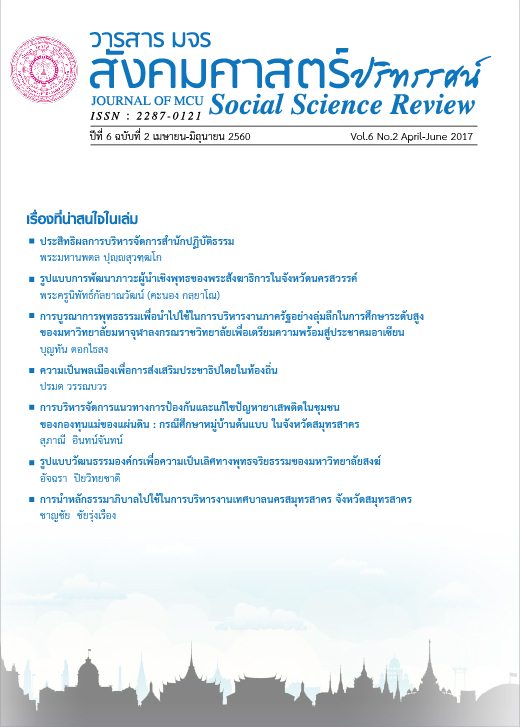การเสริมสร้างประสิทธิภาพการบริหารงานบุคลากรด้านการบิน ด้วยหลักพุทธธรรมของสถาบันการบินพลเรือน
คำสำคัญ:
การเสริมสร้างประสิทธิภาพ การบริหารงานบุคลากรด้านการบิน หลักพุทธธรรมของ สถาบันการบินพลเรือนบทคัดย่อ
การวิจัยครั้งนี้มีวัตถุประสงค์ คือ 1) เพื่อศึกษาวิเคราะห์สภาพทั่วไปและปัญหาอุปสรรคของการบริหารงานบุคลากรด้านการบินของสถาบันการบินพลเรือน 2) เพื่อศึกษาการบูรณาการทฤษฎีการบริหารและหลักพุทธธรรมที่เหมาะสมสาหรับการเสริมสร้างประสิทธิภาพการบริหารงานบุคลากรด้านการบินของสถาบันการบินพลเรือน และ 3) เพื่อนาเสนอรูปแบบการเสริมสร้างประสิทธิภาพการบริหารงานบุคลากรด้านการบินของสถาบันการบินพลเรือนระเบียบวิธีวิจัยเป็นการวิจัยแบบผสานวิธี การวิจัยเชิงคุณภาพเก็บข้อมูลจากผู้ให้ข้อมูลสาคัญ ผู้เชี่ยวชาญ ผู้บริหารองค์กรที่เกี่ยวข้องกับด้านการบินต่าง ๆ ทั้งภาครัฐและภาคเอกชน และพระภิกษุที่เชี่ยวชาญทางด้านพุทธศาสนา จานวน 26 รูป/คน ด้วยแบบสัมภาษณ์เชิงลึกที่มีโครงสร้างโดยวิธีการสัมภาษณ์เชิงลึก วิเคราะห์ข้อมูลด้วยการพรรณนาความ และการวิจัยเชิงปริมาณ เก็บข้อมูลด้วยแบบสอบถามจากกลุ่มตัวอย่าง 181 คน จาก ผู้บริหาร ครู/อาจารย์ บุคลากร เจ้าหน้าที่ของสถาบันการบินพลเรือน ในเขตพื้นที่กรุงเทพมหานคร และจังหวัดประจวบคีรีขันธ์ วิเคราะห์ข้อมูลด้วยสถิติ เชิงพรรณนา ได้แก่ ความถี่ ร้อยละ ค่าเฉลี่ย ส่วนเบี่ยงเบนมาตรฐาน
ผลการวิจัยพบว่า
1. สภาพทั่วไปและปัญหาของการบริหารบุคลากรด้านการบิน ทั้งภาควิชาการและภาค อากาศ จัดการเรียนการสอนหลักสูตรฝึกอบรมหลักสูตร ยังไม่สอดคล้องเวลาและความต้องการของ ตลาดแรงงาน การปฏิบัติงานขาดความยืดหยุ่น สถาบันการบินพลเรือน ดาเนินการมาเป็นระยะ เวลานานเป็นองค์กร นาดเล็ก สังกัดกระทรวงคมนาคม ที่มีเป้าหมายงานทางด้านการขนส่งทาง อากาศเท่านั้น 1) ด้านการวางแผน การบริหารบุคลากรด้านการบินขาดการวางแผนในระยะยาวเนื่องจากบุคลากรต้องเป็นผู้มีประสบการณ์และทักษะทางวิชาชีพ ต้องว่าจ้างบุคคลจากภายนอกที่มีคุณสมบัติเป็นไปตามข้อกาหนดมีคุณวุฒิ ทักษะทางวิชาชีพมาดาเนินการฝึกสอน 2) ด้านการสรรหา บุคลากรแต่ละระดับมีเกณฑ์การคัดเลือกต่างกันระบบการสรรหาบุคคลยึดแนวทางตามวัตถุประสงค์ความต้องการ สถาบันการบินพลเรือน มีข้อจากัด มีผู้มาสมัครน้อย โดยเฉพาะตาแหน่งครูอาจารย์ เนื่องจากขาดแรงจูงใจในหลายทางจึงได้บุคลากรที่ตรงคุณสมบัติ แต่ขาดประสบการณ์หรือไม่ได้คนเก่งมาทางาน 3) ด้านการพัฒนา การฝึกอบรมบุคลากรด้านการบินต้องอิงกับงบประมาณ โครงสร้างอัตรากาลัง คุณสมบัติเฉพาะตาแหน่งต้องตรงกับข้อกาหนดที่ได้ระบุไว้ จัดให้มีการฝึกอบรมทางสายวิชาการหรือสายบริหาร และสอดรับกับความต้องการของสังคมนานาชาติด้านการบิน 4) ด้านการธารงรักษา การคัดเลือกคนใหม่พัฒนาคนเก่าเลือกใช้คนเก่ง รักษาไว้ทั้งคนเก่านเก่ง1. การบูรณาการทฤษฎีการบริหารและหลักพุทธธรรม พบว่าบุคลากรมีความคิดเห็นว่าการเสริมสร้างประสิทธิภาพการบริหารงานบุคลากรด้านการบินด้วยหลักอิทธิบาท 4 โดยรวม อยู่ในระดับปานกลาง ( = 3.24) เมื่อพิจารณารายด้านพบว่าอยู่ในระดับปานกลางทุกด้าน ดังนี้ ด้านฉันทะ (ความพอใจ, = 3.26) โดยองค์กรกาหนดแผนยุทธศาสตร์ และการพัฒนา เพื่อบริหารและขับเคลื่อนองค์กร ให้สอดคล้องกับวิสัยทัศน์ พันธกิจ และวัตถุประสงค์ ด้านวิริยะ (ความ
พยายาม, = 3.23) โดยจัดระบบประเมินผล ติดตาม กากับดูแลการดาเนินงานขององค์กร เพื่อเพิ่มศักยภาพขององค์กรให้มีมาตรฐานสากลสามารถแข่งขันกับคู่แข่งในตลาดได้ ด้านจิตตะ (การเอาใจใส่, = 3.25) โดยการกากับติดตามและตรวจสอบการดาเนินงานขององค์กร ให้เป็นไปตามแผนงานสอดคล้องกับกฎหมาย ระเบียบ ข้อบังคับ และมีมาตรฐาน และ ด้านวิมังสา (การไตร่ตรองด้วยเหตุผล, = 3.22) ทบทวนและวิเคราะห์ จัดสรรงบประมาณอานวยความสะดวกต่อการเรียนการสอนและการปฏิบัติงาน ให้สอดคล้องกับแผนยุทธศาสตร์ขององค์กร ตามลาดับ
2. รูปแบบการบริหารงานบุคลากรด้านการบินของสถาบันการบินพลเรือนด้วยหลักอิทธิบาท 4 คือ “PRDMCVCVC MODEL” มีดังนี้ด้านการวางแผน บูรณาการเชิงพุทธโดยการวางแผนการคัดเลือกบุคลากร ตามภารกิจแต่ละหน้าที่นโยบาย วัตถุประสงค์ โครงสร้างบุคลากรด้านการสรรหา บูรณาการเชิงพุทธโดยการคัดเลือกบุคลากรตามนโยบายหน่วยงานที่ต้องการคุณสมบัติ ความรู้ ความสามารถเฉพาะด้าน มีลักษณะตั้งใจมุ่งมั่น มีความใฝ่รู้ในอาชีพด้านการพัฒนา บูรณาการเชิงพุทธโดยการใส่ใจและส่งเสริมบุคลากรให้ได้รับการอบรม เพิ่มความรู้ในวิชาชีพ มีธรรมะในการปฏิบัติงานด้านการธารงรักษา บูรณาการเชิงพุทธโดยการปลูกฝังความรับผิดชอบในหน้าที่ ใส่ใจการทางาน คิดสร้างสรรค์ ทาให้เกิดการเรียนรู้ คิดสร้างสรรค์ต่อหน้าที่และองค์กร พัฒนาคนใหม่รักษาคนเก่า สร้างขวัญและกาลังใจในการทางาน เพิ่มแรงจูงใจ ให้รางวัลเป็นการตอบแทนการบูรณาการการบริหารงานบุคคลกับหลักพุทธธรรม “อิทธิบาท 4” ที่มีความเหมาะสมและมีความสอดคล้องเป็นรูปแบบ ““PRDMCVCV MODEL” ซึ่งจะช่วยส่งเสริมประสิทธิภาพการบริหารงานบุคลากรด้านการบินของสถาบันการบินพลเรือน ได้บรรลุวัตถุประสงค์ขององค์กรตามที่กาหนดไว้
เอกสารอ้างอิง
Civil Aviation Institute. (2556). Annual Report of Civil Aviation Institute 2556. Bangkok: Civil Aviation Institute.
Paktiwat Vachirapanlop, Lft.Air Mashall. (2553). Approaches to the Improvement of the Civil Aviation Institute. Paper of Vision Proposal for Application for the Position of Director of Cilvil Aviation Institute
Patanasorn Kiettithikun. (2558, Septernber-December). Model of Buddhadhamm Integration for Personnel Working Efficiency of State Enterprise Personnel. Bangkok. MCU Journal of Social Sciences, 4(2).
ดาวน์โหลด
เผยแพร่แล้ว
รูปแบบการอ้างอิง
ฉบับ
ประเภทบทความ
สัญญาอนุญาต
ลิขสิทธิ์ (c) 2018 วารสาร มจร สังคมศาสตร์ปริทรรศน์

อนุญาตภายใต้เงื่อนไข Creative Commons Attribution-NonCommercial-NoDerivatives 4.0 International License.
เพื่อให้เป็นไปตามกฎหมายลิขสิทธิ์ ผู้นิพนธ์ทุกท่านต้องลงลายมือชื่อในแบบฟอร์มใบมอบลิขสิทธิ์บทความให้แก่วารสารฯ พร้อมกับบทความต้นฉบับที่ได้แก้ไขครั้งสุดท้าย นอกจากนี้ ผู้นิพนธ์ทุกท่านต้องยืนยันว่าบทความต้นฉบับที่ส่งมาตีพิมพ์นั้น ได้ส่งมาตีพิมพ์เฉพาะในวารสาร มจร สังคมศาสตร์ปริทรรศน์ เพียงแห่งเดียวเท่านั้น หากมีการใช้ภาพหรือตารางหรือเนื้อหาอื่นๆ ของผู้นิพนธ์อื่นที่ปรากฏในสิ่งตีพิมพ์อื่นมาแล้ว ผู้นิพนธ์ต้องขออนุญาตเจ้าของลิขสิทธิ์ก่อน พร้อมทั้งแสดงหนังสือที่ได้รับการยินยอมต่อบรรณาธิการ ก่อนที่บทความจะได้รับการตีพิมพ์ หากไม่เป็นไปตามข้อกำหนดเบื้องต้น ทางวารสารจะถอดบทความของท่านออกโดยไม่มีข้อยกเว้นใดๆ ทั้งสิ้น





